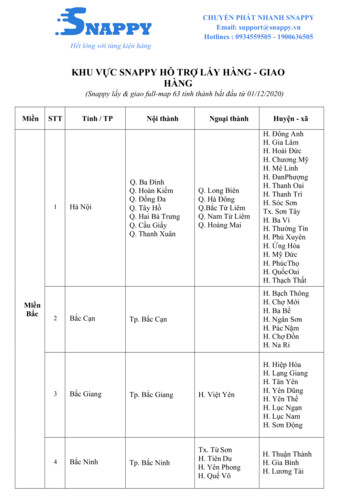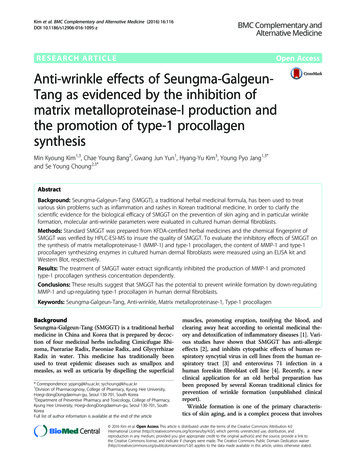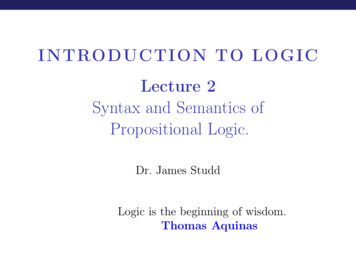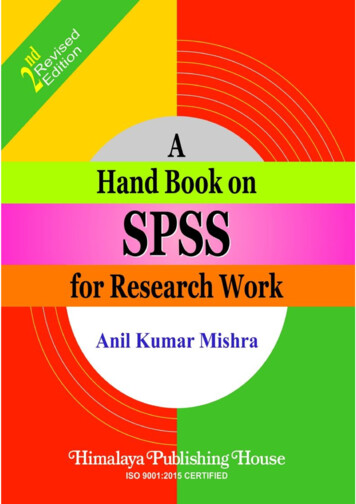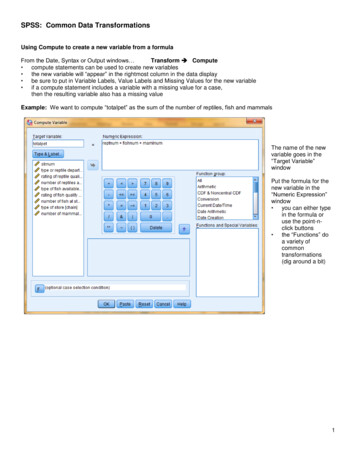
Transcription
English Syntax: An IntroductionJong-Bok Kim and Peter SellsJanuary 11, 2008CENTER FOR THE STUDYOF LANGUAGEAND INFORMATION
ContentsPreface12xiSome Basic Properties of English Syntax11.1Some Remarks on the Essence of Human Language1.2How We Discover Rules1.3Why Do We Study Syntax and What Is It Good for?1.4Exercises479From Words to Major Phrase Types2.1Introduction2.2Lexical Categories1111122.2.1 Determining the Lexical Categories2.3Grammar with Lexical Categories2.4Phrasal Categories2.5Phrase Structure Rules1217192.5.1 NP: Noun Phrase2.5.2 VP: Verb Phrase2222232.5.3 AP: Adjective Phrase252.5.4 AdvP: Adverb Phrase252.5.5 PP: Preposition Phrase312.6Grammar with Phrases2.7Exercises262631Syntactic Forms, Grammatical Functions, and Semantic Roles3.1Introduction353.2Grammatical Functions36v35
vi / E NGLISH S YNTAX : A N I NTRODUCTION3.2.1 Subjects363.2.2 Direct and Indirect Objects383.2.3 Predicative Complements3.2.4 Oblique Complements3.2.5 Modifiers43940403.3Form and Function Together3.4Semantic Roles3.5Exercises414346Head, Complements, and Modifiers4.149Projections from Lexical Heads to Phrases4.1.1 Internal vs. External Syntax49494.1.2 Notion of Head, Complements, and Modifiers4.2Differences between Complements and Modifiers 4.3PS Rules, X -Rules, and Features4.4Lexicon and Feature Structures62624.4.2 Feature Structures for Linguistic Entities65664.4.4 Verb Types and Argument Structure5Exercises6771More on Subjects and Complements735.1Grammar Rules and Principles5.2Feature Specifications on the Complement Values5.2.1 Complements of Verbs73805.2.3 Complements of Common Nouns5.3Feature Specifications for the Subject5.4Clausal Complement or Subject8283845.4.1 Verbs Selecting a Clausal Complement5.4.2 Verbs Selecting a Clausal Subject84905.4.3 Adjectives Selecting a Clausal Complement5.4.4 Nouns Selecting a Clausal Complement9591935.4.5 Prepositions Selecting a Clausal ComplementExercises76765.2.2 Complements of Adjectives5.552554.4.1 Feature Structures and Basic Operations4.4.3 Argument Realization4.55094
C ONTENTS / vii6Noun Phrases and Agreement6.1Classification of Nouns6.2Syntactic Structures981006.2.3 Proper Nouns6.397986.2.1 Common Nouns6.2.2 Pronouns97100Agreement Types and Morpho-syntactic Features6.3.1 Noun-Determiner Agreement1016.3.2 Pronoun-Antecedent Agreement6.3.3 Subject-Verb AgreementSemantic Agreement Features6.5Partitive NPs and Agreement1051091096.5.2 Two Types of Partitive NPs6.5.3 Measure Noun Phrases6.6Modifying an NP1031036.46.5.1 Basic Properties1111161186.6.1 Adjectives as Prenominal Modifiers6.6.2 Postnominal Modifiers6.77Exercises118119121Raising and Control Constructions1257.1Raising and Control Predicates7.2Differences between Raising and Control Verbs7.2.1 Subject Raising and Control7.2.2 Object Raising and Control125129A Simple Transformational Approach7.4A Nontransformational Approach7.4.1 Identical Syntactic Structures1301321327.4.2 Differences in Subcategorization Information7.4.3 Mismatch between Meaning and StructureExplaining the Differences1417.5.1 Expletive Subject and Object7.5.2 Meaning Preservation1411427.5.3 Subject vs. Object Control Verbs7.6Exercises1451261267.37.5101143134138
viii / E NGLISH S YNTAX : A N I NTRODUCTION8Auxiliary Constructions1498.1Basic Issues1498.2Transformational Analyses8.3A Lexicalist Analysis8.3.1 Modals1511521528.3.2 Be and Have1558.3.3 Periphrastic do1578.3.4 Infinitival Clause Marker to8.4Explaining the NICE Properties1608.4.2 Auxiliaries with Inversion1641678.4.4 Auxiliaries with Ellipsis91608.4.1 Auxiliaries with Negation8.4.3 Contracted Auxiliaries8.5160Exercises169172Passive Constructions1759.1Introduction1759.2Relationships between Active and Passive9.3Approaches to Passive1761789.3.1 From Structural Description to Structural Change9.3.2 A Transformational Approach9.3.3 A Lexicalist Approach9.4Prepositional Passives9.5Exercises10 Wh-Questions17918018619019310.1 Clausal Types and Interrogatives19310.2 Movement vs. Feature Percolation19510.3 Feature Percolation with No Abstract Elements10.3.1 Basic Systems19710.3.2 Non-subject Wh-questions10.3.3 Subject Wh-Questions10.4 Indirect Questions10.4.1 Basic Structure20820810.4.3 Infinitival Indirect Questions10.4.4 Adjunct wh-questions22019920410.4.2 Non-Wh Indirect Questions10.5 Exercises178217213214197
C ONTENTS / ix11 Relative Clause Constructions11.1 Introduction22322311.2 Non-subject Wh-Relative Clauses11.3 Subject Relative Clauses11.4 That-relative clauses22422923111.5 Infinitival and Bare Relative Clauses23311.6 Restrictive vs. Nonrestrictive Relative Clauses11.7 Constraints on the GAP11.8 Exercises23623924312 Special Constructions12.1 Introduction24524512.2 ‘Easy’ Constructions12.2.1 Basic Properties24624612.2.2 Transformational Analyses12.2.3 A Lexicalist Analysis12.3 Extraposition24724825212.3.1 Basic Properties25212.3.2 Transformational Analysis12.3.3 A Lexicalist Analysis12.4 Cleft constructions12.4.1 Basic Properties25325425825812.4.2 Distributional Properties of the Three clefts25912.4.3 Syntactic Structures of the Three Types of Cleft: Movement Analyses12.4.4 Lexically-Based Analyses12.5 ExercisesReferencesIndex273285270262260
PrefaceOne important aspect of teaching English syntax (to native and nonnative undergraduate students alike) involves the balance in the overall approach between facts and theory. We understand that one important goal of teaching English syntax to undergraduate students is to helpstudents enhance their understanding of the structure of English in a systematic and scientificway. Basic knowledge of this kind is essential for students to move on the next stages, in whichthey will be able to perform linguistic analyses for simple as well as complex English phenomena. This new introductory textbook has been developed with this goal in mind. The bookfocuses primarily on the descriptive facts of English syntax, presented in a way that encouragesstudents to develop keen insights into the English data. It then proceeds with the basic, theoretical concepts of generative grammar from which students can develop abilities to think, reason,and analyze English sentences from linguistic points of view.We owe a great deal of intellectual debt to the previous textbooks and literature on Englishsyntax. In particular, much of the content, as well as our exercises, has been inspired by andadopted from renowned textbooks such as Aarts (1997), Baker (1997), Borsley (1991, 1996),Radford (1988, 1997, 2004), Sag et al. (2003), to list just a few. We acknowledge our debt tothese works, which have set the course for teaching syntax over the years.Within this book, Chapters 1 to 5 cover the fundamental notions of English grammar. Westart with the basic properties of English words, and then rules for combining these words toform well-formed phrases and, ultimately, clauses. These chapters guide students through thebasic concepts of syntactic analysis such as lexical categories, phrasal types, heads, complements, and modifiers. In Chapter 4, as a way of formalizing the observed generalizations, thetextbook introduces the feature structure system of Head-Driven Phrase Structure Grammar(HPSG, Pollard and Sag (1994), Sag et al. (2003)) which places strong emphasis on the role oflexical properties and the interactions among grammatical components.From Chapter 6 on, the book discusses major constructions of English within a holistic viewof grammar allowing interactions of various grammatical properties including syntactic forms,their grammatical functions, their semantic roles, and overall aspects of clausal meaning. InChapter 6, we introduce English subject verb agreement, and concentrate on interrelationshipsxi
xii / E NGLISH S YNTAX : A N I NTRODUCTIONamong different grammatical components which play crucial interacting roles in English agreement phenomena. In particular, this chapter shows that once we allow morphological information to interface with the system of syntax, semantics, or even pragmatics, we can provide goodsolutions for some puzzling English agreement phenomena, within a principled theory. Chapter7 covers raising and control phenomena, and provides insights into the properties of the twodifferent constructions, which are famously rather similar in terms of syntactic structures, butdifferent in terms of semantics. Chapter 8 deals with the English auxiliary system, itself remarkable in that a relatively small number of elements interact with each other in complicated andintriguing ways. This chapter assigns the precise lexical information to auxiliary verbs and constructional constraints sensitive to the presence of an auxiliary verb. This allows us to expressgeneralizations among auxiliary-sensitive phenomena such as negation, inversion, contraction,and ellipsis, which we would otherwise be missed.From Chapter 9 through Chapter 12, the textbook discusses how to capture systematic relations between related constructions. Chapter 9 deals with the relationships between activeand passive voice clauses. Studying this chapter, students will be able to fully understand why,how, and when to choose between canonical and passive constructions. Chapters 10 and 11 dealwith wh-questions and relative clause constructions, often called non-local or long-distance dependency constructions, in the sense that a gap and its filler are in a potentially long-distancerelationship. These two chapters present the basic properties of these constructions and showhow the mechanism of feature percolation is a crucial part of a systematic account for them.The final chapter of the book covers the so-called ‘tough’ constructions, extraposition, and cleftconstructions. These constructions are also based on long-distance dependencies, but differentfrom the constructions in chapters 10 and 11. The goal of all these chapters is the present agroundwork of facts, which students will then have in hand, in order to consider theoreticalaccounts which apply in precise ways.We have tried to make each chapter maximally accessible. We provide clear, simple treediagrams which will help students understand the structures of English and develop analyticskills to English syntax. The theoretical notions are kept as simple yet precise as possible sothat students can apply and use them in analyzing English sentences. Each chapter also containsexercises ranging from simple to challenging, aiming to promote deeper understanding of thefactual and theoretical contents of each chapter.Numerous people have helped us in writing this textbook, in various ways. We thank fortheir comments in various places, help and interest in our textbook: [.] Wealso thank teachers and colleagues in Kyung Hee University and Stanford University for theirconstant encouragement over the years. Our gratitude also goes to undergraduate and graduatestudents at Kyung Hee University who used the draft of this as the textbook and raised so manyquestions that help us reshape its structure as well as contents. We also thank Jinyoung Kim,Dongjun Lee, and Juwon Lee for their administrative help. We also owe out thanks to DikranKaragueuzian, Director of CSLI Publications, for his patience and support, as well as LauriKanerva for his help in matters of production. We also thank Kaunghi Un for helping us with
P REFACE / xiiiLATEX problems.Lastly, but not the least, we also truly thank our close friends and family members who gaveus unconditional love and support in every possible regard. We dedicate this book to our belovedones who with true love and refreshing and comforting words have lead us to think ‘wise andsyntactic’ when we are spiritually and physically down.
1Some Basic Properties of English Syntax1.1Some Remarks on the Essence of Human LanguageOne of the crucial functions of any human language, such as English or Korean, is to conveyvarious kinds of information from the everyday to the highly academic. Language provides ameans for us to describe how to cook, how to remove cherry stains, how to understand Englishgrammar, or how to provide a convincing argument. We commonly consider certain propertiesof language to be key essential features from which the basic study of linguistics starts.The first well-known property (as emphasized by Saussure 1916) is that there is no motivated relationship between sounds and meanings. This is simply observed in the fact thatthe same meaning is usually expressed by a different sounding-word in a different language(think of house, maison, casa). For words such as hotdog, desk, dog, bike, hamburger, cranberry, sweetbread, their meanings have nothing to do with their shapes. For example, the wordhotdog has no relationship with a dog which is or feels hot. There is just an arbitrary relationship between the word’s sound and its meaning: this relationship is decided by the conventionof the community the speakers belong to.The second important feature of language, and one more central to syntax, is that languagemakes infinite use of finite set of rules or principles, the observation of which led the development of generative linguistics in the 20th century (cf. Chomsky 1965). A language is asystem for combining its parts in infinitely many ways. One piece of evidence of the system canbe observed in word-order restrictions. If a sentence is an arrangement of words and we have5 words such as man, ball, a, the, and kicked, how many possible combinations can we havefrom these five words? More importantly, are all of these combinations grammatical sentences?Mathematically, the number of possible combinations of 5 words is 5! (factorial), equalling120 instances. But among these 120 possible combinations, only 6 form grammatical Englishsentences:1(1) a. The man kicked a ball.1 Examples like (1e) and (1f) are called ‘topicalization’ sentences in which the topic expression (the ball and theman), already mentioned and understood in the given context, is placed in the sentence initial position. See Lambrecht(1994) and references therein.1
2 / E NGLISH S YNTAX : A N I NTRODUCTIONb. A man kicked the ball.c. The ball kicked a man.d. A ball kicked the man.e. The ball, a man kicked.f. The man, a ball kicked.All the other 114 combinations, a few of which are given in (2), are unacceptable to nativespeakers of English. We use the notation * to indicate that a hypothesized example is ungrammatical.(2) a. *Kicked the man the ball.b. *Man the ball kicked the.c. *The man a ball kicked.It is clear that there are certain rules in English for combining words. These rules constrainwhich words can be combined together or how they may be ordered, sometimes in groups, withrespect to each other.Such combinatory rules also play important roles in our understanding of the syntax of anexample like (3a).2 Whatever these rules are, they should give a different status to (3b), anexample which is judged ungrammatical by native speakers even though the intended meaningof the speaker is relatively clear and understandable.(3) a. Kim lives in the house Lee sold to her.b. *Kim lives in the house Lee sold it to her.The requirement of such combinatory knowledge also provides an argument for the assumptionthat we use just a finite set of resources in producing grammatical sentences, and that we do notjust rely on the meaning of words involved. Consider the examples in (4):(4) a. *Kim fond of Lee.b. Kim is fond of Lee.Even though it is not difficult to understand the meaning of (4a), English has a structural requirement for the verb is as in (4b).More natural evidence of the ‘finite set of rules and principles’ idea can be found in cognitive,creative abilities. Speakers are unconscious of the rules which they use all the time, and have nodifficulties in producing or understanding sentences which they have never heard, seen, or talkedabout before. For example, even though we may well not have seen the following sentencebefore, we can understand its meaning if we have a linguistic competence in English:(5) In January 2002, a dull star in an obscure constellation suddenly became 600,000 timesmore luminous than our Sun, temporarily making it the brightest star in our galaxy.A related part of this competence is that a language speaker can produce an infinite numberof grammatical sentences. For example, given the simple sentence (6a), we can make a more2 Startingin Chapter 2, we will see these combinatory rules.
S OME BASIC P ROPERTIES OF E NGLISH S YNTAX / 3complex one like (6b) by adding the adjective tall. To this sentence, we can again add anotheradjective handsome as in (6c). We could continue adding adjectives, theoretically enabling usto generate an infinitive number of sentences:(6) a. The man kicked the ball.b. The tall man kicked the ball.c. The handsome, tall man kicked the ball.d. The handsome, tall, nice man kicked the ball.e. . . .One might argue that since the number of English adjectives could be limited, there would be adead-end to this process. However, no one would find themselves lost for another way to keepthe process going (cf. Sag et al. 2003):(7) a. Some sentences can go on.b. Some sentences can go on and on.c. Some sentences can go on and on and on.d. Some sentences can go on and on and on and on.e. . . .To (7a), we add the string and on, producing a longer one (7b). To this resulting sentence (7c),we once again add and on. We could in principle go on adding without stopping: this is enoughto prove that we could make an infinite number of well-formed English sentences.3Given these observations, how then can we explain the fact that we can produce or understand an infinite number of grammatical sentences that we have never heard or seen before? Itseems implausible to consider that we somehow memorize every example, and in fact we do not(Pullum and Scholz 2002). We know that this could not be true, in particular when we considerthat native speakers can generate an infinite number of infinitely long sentences, in principle. Inaddition, there is limit to the amount of information our brain can keep track of, and it wouldbe implausible to think that we store an infinite number of sentences and retrieve whenever weneed to do so.These considerations imply that a more appropriate hypothesis would be something like (8):4(8) All native speakers have a grammatical competence which can generate an infinite setof grammatical sentences from a finite set of resources.This hypothesis has been generally accepted by most linguists, and has been taken as the subjectmatter of syntactic theory. In terms of grammar, this grammatical competence is hypothesizedto characterize a generative grammar, which we then can define as follows (for English, inthis instance):3 Think of a simple analogy:what is the longest number? Yet, how many numbers do you know? The second questiononly makes sense if the answer is 0–9 (ten digits).4 The notion of ‘competence’ is often compared with that of ‘performance’ (Chomsky 1965). Competence refersto speakers’ internalized knowledge of their language, whereas performance refers to actual usage of this abstractknowledge of language.
4 / E NGLISH S YNTAX : A N I NTRODUCTION(9) Generative Grammar:An English generative grammar is the one that can generate an infinite set of well-formedEnglish sentences from a finite set of rules or principles.The job of syntax is thus to discover and formulate these rules or principles.5 These rules tell ushow words are put together to form grammatical phrases and sentences. Generative grammar,or generative syntax, thus aims to define these rules which will characterize all of the sentenceswhich native speakers will accept as well-formed and grammatical.1.2How We Discover RulesHow can we then find out what the generative rules of English syntax are? These rules arepresent in the speakers’ minds, but are not consciously accessible; speakers cannot articulatetheir content, if asked to do so. Hence we discover the rules indirectly, and of the several methods for inferring these hidden rules, hypotheses based on the observed data of the given language are perhaps the most reliable. These data can come from speakers’ judgments – knownas intuitions – or from collected data sets – often called corpora. Linguistics is in one sensean empirical science as it places a strong emphasis on investigating the data underlying a phenomenon of study.The canonical steps for doing empirical research can be summarized as follows:. Step I: Data collection and observation. Step II: Make a hypothesis to cover the first set of data. Step III: Check the hypothesis with more data. Step IV: Revise the hypothesis, if necessary.Let us see how these steps work for discovering one of the grammar rules in English, in particular, the rule for distinguishing count and non-count nouns:6[Step I: Observing Data] To discover a grammar rule, the first thing we need to do is tocheck out grammatical and ungrammatical variants of the expression in question. For example,let us look at the usage of the word evidence:(10)Data Set 1: evidencea. *The professor found some strong evidences of water on Mars.b. *The professor was hoping for a strong evidence.5 In generative syntax, ‘rules’ refers not to ‘prescriptive rules’ but to ‘descriptive rules’. Prescriptive rules are thosewhich disfavor or even discredit certain usages; these prescribe forms which are generally in use, as in (i). Meanwhile,descriptive rules are meant to characterize whatever forms speakers actually use, with any social, moral, or intellectualjudgement.(i)a.b.c.Do not end a sentence with a preposition.Avoid double negatives.Avoid split infinitives.The spoken performance of most English speakers will often contain examples which violate such prescriptive rules.6 Much of the discussion and data in this section are adopted from Baker, C.L. (1995).
S OME BASIC P ROPERTIES OF E NGLISH S YNTAX / 5c. *The evidence that John found was more helpful than the one that Smith found.What can you tell from these examples? We can make the following observations:(11)Observation 1:a. evidence cannot be used in the plural.b. evidence cannot be used with the indefinite article a(n).c. evidence cannot be referred to by the pronoun one.In any scientific research one example is not enough to draw any conclusion. However, wecan easily find more words that behave like evidence:(12)Data Set 2: equipmenta. *We had hoped to get three new equipments every month, but we only had enoughmoney to get an equipment every two weeks.b. *The equipment we bought last year was more expensive than the one we bought thisyear.We thus extend Observation 1 a little bit further:(13)Observation 2:a. evidence/equipment cannot be used in the plural.b. evidence/equipment cannot be used with the indefinite article a(n).c. evidence/equipment cannot be referred to by the pronoun one.It is usually necessary to find contrastive examples to understand the range of a given observation. For instance, words like clue and tool act differently:(14)Data Set 3: cluea. The professor gave John some good clues for the question.b. The student was hoping for a good clue.c. The clue that John got was more helpful than the one that Smith got.(15)Data Set 4: toola. The teacher gave John some good tools for the purpose.b. The student was hoping for a tool.c. The tool that Jones got was more helpful than the one that Smith got.Unlike equipment and evidence, the nouns clue and tool can be used in the test linguistic contexts we set up. We thus can add Observation 3, different from Observation 2:(16)Observation 3:a. clue/tool can be used in the plural.b. clue/tool can be used with the indefinite article a(n).c. clue/tool can be referred to by the pronoun one.
6 / E NGLISH S YNTAX : A N I NTRODUCTION[Step II: Forming a Hypothesis] From the data and observations we have made so far, canwe make any hypothesis about the English grammar rule in question? One hypothesis that wecan make is something like the following:(17)First Hypothesis:English has at least two groups of nouns, Group I (count nouns) and Group II (noncount nouns), diagnosed by tests of plurality, the indefinite article, and the pronounone.[Step III: Checking the Hypothesis] Once we have formed such a hypothesis, we need tocheck out if it is true of other data, and also see if it can bring other analytical consequences.A little further thought allows us to find support for the two-way distinction for nouns. Forexample, consider the usage of much and many:(18) a. much evidence, much equipment, information, much furniture, much adviceb. *much clue, *much tool, *much armchair, *much bags(19) a. *many evidence, *many equipment, *many information, *many furniture, *many adviceb. many clues, many tools, many suggestions, many armchairsAs observed here, count nouns can occur only with many, whereas non-count nouns can combine with much. Similar support can be found from the usage of little and few:(20) a. little evidence, little equipment, little advice, little informationb. *little clue, *little tool, *little suggestion, *little armchair(21) a. *few evidence, *few equipment, *few furniture, *few advice, *few informationb. few clues, few tools, suggestions, few armchairsThe word little can occur with non-count nouns like evidence, yet few cannot. Meanwhile, fewoccurs only with count nouns.Given these data, it appears that the two-way distinction is quite plausible and persuasive.We can now ask if this distinction into just two groups is really enough for the classification ofnouns. Consider the following examples with cake:(22) a. The mayor gave John some good cakes.b. The president was hoping for a good cake.c. The cake that Jones got was more delicious than the one that Smith got.Similar behavior can be observed with a noun like beer, too:(23) a. The bartender gave John some good beers.b. No one knows how to tell from a good beer to a bad one.These data show us that cake and beer may be classified as count nouns. However, observethe following:
S OME BASIC P ROPERTIES OF E NGLISH S YNTAX / 7(24) a. My pastor says I ate too much cake.b. The students drank too much beer last night.(25) a. We recommend to eat less cake and pastry.b. People now drink less beer.The data mean that cake and beer can also be used as non-count nouns since that can be usedwith less or much.[Step IV: Revising the Hypothesis] The examples in (24) and (25) imply that there is another group of nouns that can be used as both count and non-count nouns. This leads us to revisethe hypothesis in (17) as following:(26) Revised Hypothesis:There are at least three groups of nouns: Group 1 (count nouns), Group 2 (non-countnouns), and Group 3 (count and non-count).We can expect that context will determine whether a Group 3 noun is used as count or as noncount.As we have observed so far, the process of finding finite grammar rules crucially hinges onfinding data, drawing generalizations, making a hypothesis, and revising this hypothesis withmore data.1.3Why Do We Study Syntax and What Is It Good for?There are many reasons for studying syntax, from general humanistic or behavioral motivationsto much more specific goals such as those in the following:. To help us to illustrate the patterns of English more effectively and clearly. To enable us to analyze the structure of English sentences in a systematic and explicit way.For example, let us consider how we could use the syntactic notion of head, which refersto the essential element within a phrase. The following is a short and informal rule for Englishsubject-verb agreement.7(27) In English, the main verb agrees with the head element of the subject.This informal rule can pinpoint what is wrong with the following two examples:(28) a. *The recent strike by pilots have cost the country a great deal of money from tourismand so on.b. *The average age at which people begin to need eyeglasses vary considerably.Once we have structural knowledge of such sentences, it is easy to see that the essential elementof the subject in (28a) is not pilots but strike. This is why the main verb should be has but nothave to observe the basic agreement rule in (27). Meanwhile, in (28b), the head is the noun age,and thus the main verb vary needs to agree with this singular noun. It would not do to simply7 Thenotion of ‘subject’ is further discussed in Chapter 3 and that of ‘head’ in Chapter 4.
8 / E NGLISH S YNTAX : A N I NTRODUCTIONtalk about ‘the noun’ in the subject in the examples in (28), as there is more than one. We needto be able to talk about the one which gives its character to the phrase, and this is the head. Ifthe head is singular, so is the whole phrase, and similarly for plural. The head of the subject andthe verb (in the incorrect form) are indicated in (29):(29) a. *[The recent strike by pilots] have cost the country a great deal of money fromtourism and so on.b. *[The average age at which people begin to need eyeglasses] vary considerably.Either example can be made into a grammatical version by pluralizing the head noun of thesubject.Now let us look at some slightly different cases. Can you explain why the following examplesare unacceptable?(30) a. *Despite of his limited educational opportunities, Abraham Lincoln became one ofthe greatest intellectuals in the world.b. *A pastor was executed, notwithstanding on many applications in favor of him.To understand these examples, we first need to recognize that the words despite and notwithstanding are prepositions, and further that canonical English prepositions combine only withnoun phrases. In (30), these prepositions combine with prepositional phrases again (headed byof and on respectively), violating this rule.A more subtle instance can be found in the following:(31) a. Visiting relatives can be boring.b. I saw that gas can explode.These examples each have more than one interpretation. The first one can mean either that theevent of seeing our relatives is a boring ac
and analyze English sentences from linguistic points of view. We owe a great deal of intellectual debt to theprevious textbooks and literature on English syntax. In particular, much of the content, as well as our exercises, has been inspired by and adopted from renowned textbooks such as Aarts (1997), Baker (1997), Borsley (1991, 1996), Radford (1988, 1997, 2004), Sag et al. (2003), to list .
